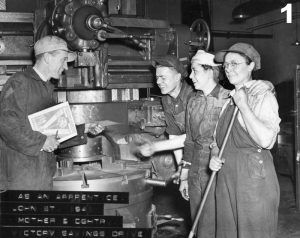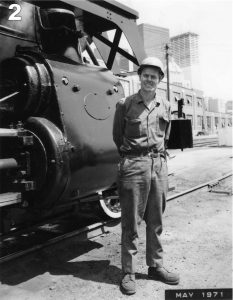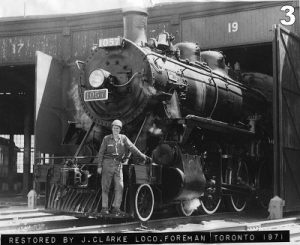A Family Affair: John Clarke, Shop Foreman
One day at the John Street Roundhouse, where the Toronto Railway Museum is located, a man walked into the museum. This man was John C. Clarke, the shop foreman of the John Street Roundhouse in the 1970s. In April 2010, John shared his story and photographs with the museum. As shop foreman, John was responsible for consulting with the engineer about repairs. The foreman assigned workers to make the repairs and write a report of the train’s condition.
John is the third of four generations of Clarkes who have worked for the Canadian Pacific Railway (CPR). Charles L. Clarke, John’s grandfather, was a bridge and building master for CPR in New Brunswick for forty years. John’s father, Donald G. Clarke, was a CPR express messenger for 47 years, mostly working out of Toronto. As of 2002, four out of five of John’s sons work for Canadian Pacific.
John was born on June 1, 1925. John’s birthday was a date that always resonated in his career. He began working for the CPR at John Street as a machinist apprentice on June 1, 1942. This was the very day he turned 18 and during the Second World War (1939-1945). He earned 30 cents an hour and worked six days a week. It was probably the busiest time ever in the 61-year (1929-1990) history of the John Street Roundhouse. There was immense pressure on the railways during the Second World War. Trains moved supplies and troops from coast to coast across the country.
There were 50 CPR trains a day scheduled in and out of Union Station in the summer of 1942, each of them hauled by a steam locomotive that needed servicing at the roundhouse. These trains were for ordinary passengers. There were more trains to move the soldiers.

In this promotion photograph for war bonds, John is pictured with a mother and daughter team working in the roundhouse, 1941.
During the war, John worked with many women in the roundhouse. With large numbers of men off to war, women took on railway jobs to keep the trains running. John participated in a promotional photograph for war bonds with a mother and daughter team. This is one of the first instances of photographic evidence of women working in the roundhouse.
John’s birthday continued to resonate in his career. He was appointed assistant foreman on June 1, 1951. This meant he had to work nights – from 4 pm to 12 am. The roundhouse ran 24 hours a day to accommodate all the locomotives that needed maintenance. John went back to day shift work on June 1, 1972 when he became the shop foreman at John Street.



